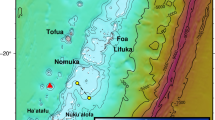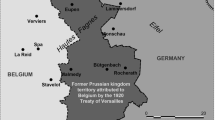Abstract
On the evening of 17 July 1998, on the Aitape Coast of Papua New Guinea, a strongly felt earthquake was followed some 10–25 minutes later by a destructive tsunami. The tsunami comprised three waves, each estimated to be about 4 m high. The second of the three waves rose to a height of 10–15 m above sea level after it had crossed the shoreline and caused most damage. Maximum wave heights and the greatest damage were recorded along a 14-km sector of coast centered on Sissano Lagoon. In this sector the wavefronts moved from east to west along the coast; all structures were destroyed, and in the two main villages 20–40 percent of the population was killed. Partial destruction extended 23 km to the southeast and 8 km to the northwest, and effects of the tsunami were felt as far as 250 km to the west-northwest, beyond the international border. More than 1600 people are known to have died, with some estimates as high as 2200; 1000 were seriously injured, and 10,000 survivors were displaced. This paper presents information from interviews with eye-witnesses and from mapping of damage and inundation, and includes new information on the height, shape and timing of the waves; on the possible escape of petroleum and other gases from beneath the seafloor before and during the tsunami; on unusual sound effects that preceded the waves, and lighting effects that followed; on possible deep circulation (to 250 m) of sea water in the waves; on subsidence of the order of 50–70 cm at the coastal sand barrier; and on the resilience and potential protective capacity of certain species of trees. Eye-witness accounts indicate that the tsunami reached the shore at between 09:00 and 09:08 UT, which is earlier than is proposed in published models of the timing and location of the source of the tsunami.
Access this chapter
Tax calculation will be finalised at checkout
Purchases are for personal use only
Preview
Unable to display preview. Download preview PDF.
Similar content being viewed by others
References
Bolt, B. A. Earthquakes (New York, Freeman 4th edition 1999).
Carey, S. W. (1935), Preliminary Notes on a Recent Earthquake in New Guinea, Australian Geographer 2(8), 8–15.
Davies, H. L. (1998a), Tsunami PNG 1998 - Extracts from Earth Talk, Waigani, University of Papua New Guinea.
Davies, H. L. (1998b), Sissano Tsunami: A Reconstruction of the Events of July 17, 1998,Based upon Interviews with Survivors. 1998 Fall Meeting American Geophysical Union, Supplement to EOS, Transactions AGU 79(45), p. F572.
Davies, H. L., Davies, J. M., Lus, W. Y., Perembo, R. C. B., Joku, N., Gedikile, H., and Nongkas, M. (2000), Tsunami at Aitape - “Is it Safe to Go Back?” (abstr.). Proc. 15th Australian Geological Convention, Geological Society of Australia Abstracts 45.
Davies, H. L. (in prep.), Report on the Aitape 1998 Tsunami, Waigani, PNG National Disaster Management Office.
Davies, H. L., Davies, J. M., Lus, W. Y., Perembo, R. C. B., Joku, N., Gedikile, H., and Nongkas, M. (2001), Learning from the Aitape Tsunami, Proc. Internati. Tsunami Symp. ITS2001, Seattle.
Davies, J. M., Davies, H. L., JoKu, N., and Gedikile, H. (1999), The Aitape Tsunami - reconstructing the events and planning for the future at PARTIC,1999 Fall Meeting Am. Geophys. Union, Supplement to EOS, Transactions AGU 80 p. F750.
Everingham, I. B. (1977), Preliminary Catalogue of Tsunamis for the New Guinea/Solomon Region, 17681972,Bureau of Mineral Resources, Australia, Report 180.
Geist, E. L. (2000), Origin of the 17 July 1998 Papua New Guinea Tsunami: Earthquake or Landslide? Seismol. Res. Lett. 71, 344–351.
Goldsmith, P., Barnett, A., Goff, J., Mcsaveney, M., Elliott, S., and Nongkas, M. (1999), Report of the New Zealand Reconnaissance Team to the Area of the 17 July 1998 Tsunami at Sissano Lagoon, Papua New Guinea, Bull. NZ Soc. Earthq. Engin. 32, 102–118.
Hasiotis, T., Papatheodorou, G., Kastanos, N., and Ferentinos, G. (1996), A Pockmark Bed in the Patras Gulf (Greece) and its Activation during the 4/7/93 Seismic Event. Marine Geology 130, 333–344.
Holian, A. C., and Keith, P. P. (1998), Orthopaedic Surgery after the Aitape Tsunami, Medical J. Australia 169, 606–609.
Hovland, M., and Judd, A. G., Seabed Pockmarks and Seepages (London, Graham and Trotman 1988).
Hurukawa, N., Tsuji, Y., and Waluyo, B. (2003), The 1998 Papua New Guinea Earthquake and its Fault Plane Estimated from Relocated Aftershocks, Pure appl. geophys. 160, 1829–1841.
Iida, K. (1958), Magnitude and Energy of Earthquakes Accompanied by Tsunami, and Tsunami Energy,J. Earth Sciences, Nagoya University 6, 101–112.
ITST (1998), Preliminary Report on the Tsunami Caused by the Earthquake at Sissano, West Sepik, PNG, on 17 July 1998, International Tsunami Survey Team unpublished report, September 1998.
Jaffe, B., Gelfenbaum, G., Benson, B., Davies, H., and Nongkas, M. (1998), Sedimentation,Erosion and Flow in the July 17, 1998 Papua New Guinea Tsunami, 1998 Fall Meeting Am. Geophys. Union, Supplement to EOS, Transactions AGU 79(45), p. F572.
Kawata, Y., Tsuji, Y., Matsutomi, H., Imamura, F., Matsuyama, M., and Takahashi, T. (1999a), Field Survey of the 1998 Tsunami in the Northwestern Area of Papua New Guinea, Report to Ministry of Education, Science, Sports and Culture, Japan.
Kawata, Y., Benson, B. C., Borrero, J. C., Borrero, J. L., Davies, H. L., Delange, W. P., Imamura, F., Letz, H., Norr, J., and Synolakis, C. E. (1999), Tsunami in Papua New Guinea was as Intense as First Thought, EOS Transactions of the Am. Geophys. Union 80, pp. 101,104–105.
Komar, P. D., Beach Processes and Sedimentation. (New Jersey, Prentice Hall, 1998), 2nd edition, 543 pp.
Mccarthy, J. K. (1963), Patrol Into Yesterday,Canberra, Cheshire, p. 156.
Mcsaveney, M. J., Goff, J. R., Darby, D. J., Goldsmith, P., Barnett, A., Elliott, S., and Nongkas, M. (2000), The 17 July Tsunami, Papua New Guinea: Evidence and Initial Interpretation, Marine Geology 170, 81–92.
Matsutomi, H., Kawata, Y., Shuto, N., Tsuji, Y., Fujima, K., Imamura, F., Matsuyama, M., Takahashi, T., Maki, N., and Han, S. S., 2001, Flow Strength on Land and Damage of the 1998 Papua New Guinea Tsunami. In Tsunami Research at the End of a Critical Decade (G. T. Hebenstreit, ed.), (Dordrecht, Kluwer 2001)
National Mapping Bureau (1998), Aitape Disaster Area West Block and East Block, Aerial Photographs at 1:10,000 scale. Port Moresby, National Mapping Bureau.
Neuhauss, R., Deutsch-Neu-Guinea, 3 vols. (Berlin: Dietrich Reimer 1911).
Norvick, M. and Hutchison, D. S. (1980), Aitape-Vanimo 1:250,000 Geological Series Map and Explanatory Notes,Geological Survey of Papua New Guinea SA/54–15 and SA/54–11.
Pegler, G., Das, S., and Woodhouse, J. H. (1995), A Seismological Study of the Eastern New Guinea and the Western Solomon Sea Regions and its Tectonic Implications, Geophys. J. Internat. 122, 961–981.
Ripper, I. D., Letz, H., and Mothoi, M. (1999), Felt Effects of the 17 July 1998 Sissano Lagoon Tsunami Earthquakes, Geological Survey of Papua New Guinea Report 99/13.
Shuto, N. (1997), A natural warning of tsunami arrival. In Perspectives on Tsunami Hazard Reduction (G. Herbenstreit ed.), (Dordrecht, Kluwer 1997), pp. 157–173.
Shuto, N. (1999), A Short History of Tsunami Defense Works in Japan. In Study on Regional and Historical Change of Tsunami Disasters - In Commemoration of the 1993 Hokkaido Nansei-oki Earthquake Tsunami. Research Project, Grant-in-aid for Scientific Research (B) no. 09044126 (1998–1999), Faculty of Policy Studies, Iwate Prefectural University, pp. 35–67.
Soter, S. (1999), Macroscopic Seismic Anomalies and Submarine Pockmarks in the Corinth-Patras Rift, Greece, Tectonophysics 308, 275–290.
Sweet, S., and Silver, E. A. (2001), Seismic reflection images of the source region of the 1998 Papua New Guinea tsunami. In: Prediction of Underwater Slump and Slide Hazards. (Watts, P., Synolakis, C. E., and Bardet, J. P., eds), (Rotterdam, Balkema 2001).
Synolakis, C., Bardet, J.-P., Borrero, J., Davies, H., Okal, E., Silver, E., Sweet, S., and Tappin, D. (2002), The Slump Origin of the 1998 Papua New Guinea Tsunami, Proc. Roy. Soc. London A 458, 763–789.
Tanioka, Y. (1999), Analysis of the Far-field Tsunamis Generated by the 1998 Papua New Guinea Earthquake, Geophys. Res. Lett. 26, 3393–3396.
Tappin, D. R., Matsumoto, T., Watts, P., Satake, K., Mcmurtry, G. M., Matsuyama, M., Lafoy, Y., Tsuji, Y., Kanamatsu, T., Lus, W., Iwabachi, Y., Yeh, H., Matsumoto, Y., Nakamura, M., Moihoi, M., Hill, P., Crook, K., Anton, L., and Walsh, J. P. (1999), Sediment Slump Likely Caused the 1998 Papua New Guinea Tsunami, EOS Transact. Am. Geophys. Union 80, pp. 329, 334, 340.
Tappin, D. R., Watts, P., Mcmurtry, G. M., Lafoy, Y., and Matsumoto, T. (2001), The Sissano, Papua New Guinea Tsunami of July 1998 - Offshore Evidence of the Source Mechanism. Marine Geology 175, 1–23.
Taylor, R. P., Emonson, D. L., and Schlimmer, J. E. (1998), Operation Shaddock-The Australian Defence Force Response to the Tsunami Disaster in Papua New Guinea,Medical J. Australia 169, 602–606.
Welsch, R. L. (1998), An American Anthropologist in Melanesia. A.B. Lewis and the Joseph N. Field South Pacific Expedition 1909–1913. 2 vols. (Honolulu: University of Hawaii Press 1998).
Author information
Authors and Affiliations
Editor information
Editors and Affiliations
Rights and permissions
Copyright information
© 2003 Springer Basel AG
About this chapter
Cite this chapter
Davies, H.L., Davies, J.M., Perembo, R.C.B., Lus, W.Y. (2003). The Aitape 1998 Tsunami: Reconstructing the Event from Interviews and Field Mapping. In: Bardet, JP., Imamura, F., Synolakis, C.E., Okal, E.A., Davies, H.L. (eds) Landslide Tsunamis: Recent Findings and Research Directions. Pageoph Topical Volumes. Birkhäuser, Basel. https://doi.org/10.1007/978-3-0348-7995-8_7
Download citation
DOI: https://doi.org/10.1007/978-3-0348-7995-8_7
Publisher Name: Birkhäuser, Basel
Print ISBN: 978-3-7643-6033-7
Online ISBN: 978-3-0348-7995-8
eBook Packages: Springer Book Archive




